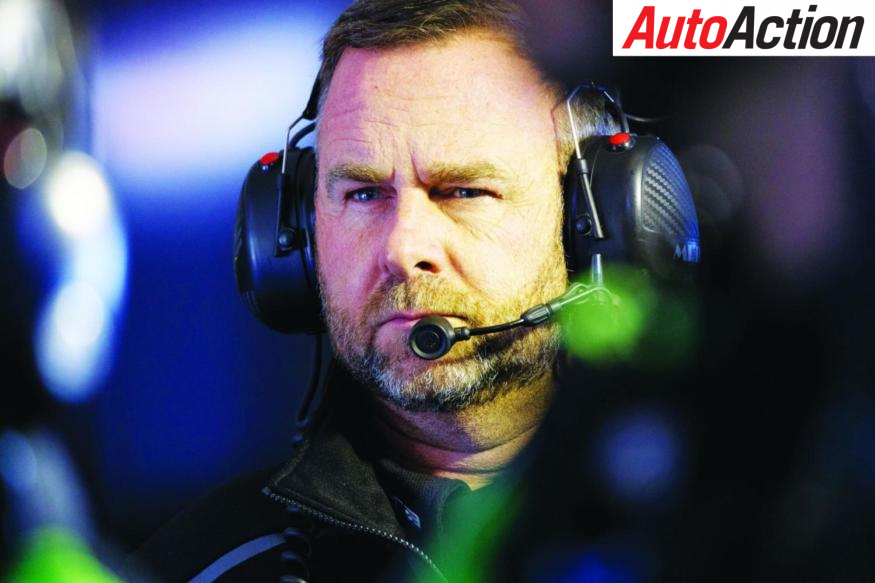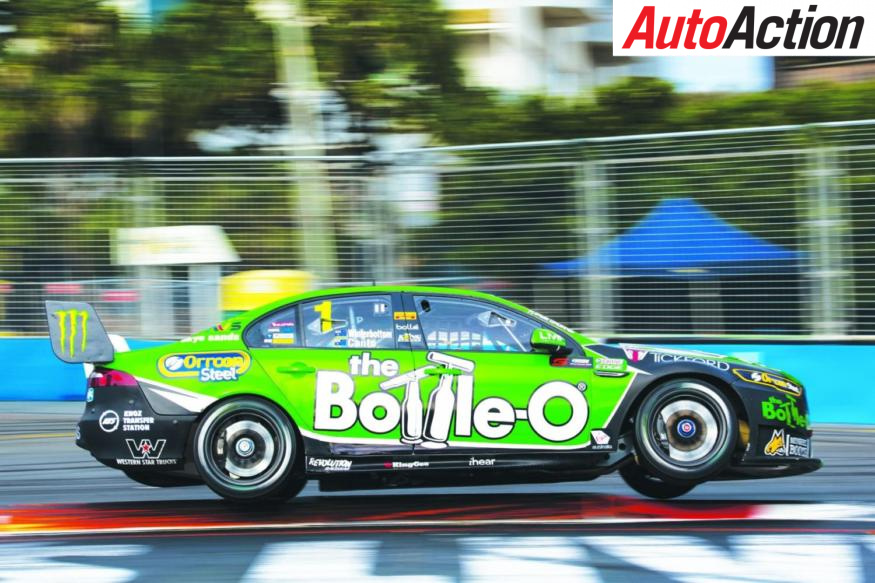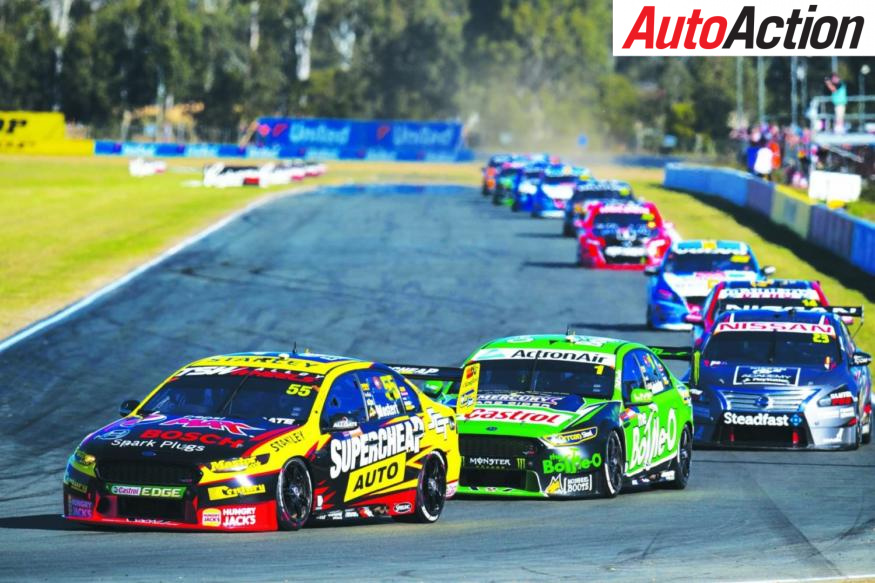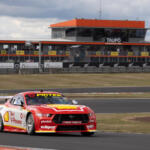A TIME OF CHANGE – 2017 PLANS FOR PRODRIVE RACING AUSTRALIA


Prodrive Racing Australia’s Bottle-O and Monster cars at the Australian Grand Prix – Photo: LAT
If 2016 brought less success than Prodrive Racing Australia wanted, plans are in place to see that does not repeat this year. PHIL BRANAGAN sat down with team boss Tim Edwards to talk about 2017 and beyond
THE BUILDING looks the same, but different.
Where once large lettering read ‘Ford Performance Racing’ on the outside of the building is now ‘Prodrive’, in line with the name change now two seasons ago.
But in the foyer, a large mural of the team’s successes is still headlined with the older epithet. There are no plans to change it; the team will be leaving for new digs some time in the next year.
There are also trophies, beyond counting. A rack holds nine surfboards, talismans for success on the streets of the Gold Coast. Four more close by will not fit in the rack; more are stored somewhere else, explains marketing boss Peter Trevaskis.
PRA has a winning culture. That was not always the case, but Mark Winterbottom’s 2015 Supercars title, and the team’s consecutive Bathurst wins, turned it around.
But 2016 delivered less success than the team wanted. Winterbottom won twice; Chaz Mostert not at all. Sixth and seventh in the Championship points was not the defence anyone had in mind.

Prodrive Racing Australia team boss Tim Edwards
But team boss Tim Edwards points out that the team improved last season – just not as much as did other teams.
“It certainly was not as good as 2015,” Edwards admits, “but we performed better. Our cars were quicker than they were in 2015. But unfortunately others improved by even more than we did in 2016.
“It was not as though we went backwards – which we did in terms of results. But we actually still moved forward in performance. The game progresses all the time and other teams made greater gains then we did.
“The bar went up. Every year, it does that, but until you are in that year, you just don’t know how high someone is going to lift that bar. Last year Triple Eight lifted the bar very high.”
So the obvious question is, what happened?
“There are a whole host of things,” he says. “There is never a silver bullet. There are always multiple things that contribute.”
When pressed to be specific what those ‘multiple things’ were, Edwards says only, “I would say we have a pretty good idea.”
An obvious place to start is with the tyres. Under a revised format more Sprint tyres were in the mix last year than in previous seasons, and at some circuits for the first time. While other teams looked to cope with the change well, PRA struggled.
“I think that our car has always performed better on the hard tyre than on the soft tyre. That is definitely a contributing factor,” says Edwards.
“But that is just a result of set-up – whether it is springs, dampers, geometry, it is all those things that can contribute to that. It is more about adjusting what we do, in the way that we approach the set-up of the car.
“But 2016 is long-gone now. We have a different construction, different shaped tyre for 2017. So what our deficiency is now may not be what our deficiency was last year. Everyone is in the same boat, and this is a big change.
We have the same, or similar, compounds, but a different construction tyre. It’s a different shape and that is going to make a huge difference to the cars. We are all, pretty much, in the dark as to what that is going to be, at the moment. You have to be a little bit careful that we do not go and re-engineer our cars to overcome the problems that we had last year, because they may not be the ones that we have this year.”
As the season unwound it became clearer that Winterbottom would not be in a position to fight for another title, so the priority became race wins – one of which came in New Zealand – and then one eye turned to 2017.
Watching the cars struggled at Homebush was a result of trying out a set-up for this season.

Mark Winterbottom’s Bottle-O backed Ford Falcon – Photo: LAT
Edwards explains, “We have to do our testing in public. That is what we were doing in Sydney. That was a terrible weekend for us, off the back of what had been a pretty good weekend before that, in New Zealand. But there was an educated decision that we should try some things in Sydney that we left-field, and things that you would not normally put on a racecar, if you were vying for the championship. But, given it was the last round and we couldn’t win the championship – we couldn’t finish even in the top three – we made the decision to explore a few things, that could help us in 2017.”
Having stood toe-to-toe with Triple Eight for half a decade, and slain the dragon in 2015, made ‘stepping down’ was even harder to deal with.
“The reality is, once you have ‘tasted the forbidden fruit’, almost, you have a taste for it,” says Edwards.
“So for us, not winning the championship was always going to be a difficult pill to swallow. You have tasted it; you know what it is like.
“It’s like when we won Bathurst. We won it, and then we won it again. When we didn’t win it last year – even when we had a reasonably strong result – we were gutted. We had achieved that before.
It is hard to keep people motivated. They get frustrated, because we have had that success. I have seen that many times before, even when I was working at Jordan. We had some very successful years in the late 1990s, and all of a sudden, the money started to peter out, the performance started to peter out and trying to keep people motivated, after they have had the successes, can be even harder than always chipping away.”
PRA is a big team. There are four Falcons being prepared for the new Supercars season and two for the Dunlop Series, one for Garry Jacobson and one for Josh Keen. There are 70 people working on the race program, but it has to be a tight ship after the parting of the ways with Ford.
“To replace manufacturer money is very difficult,” says Edwards.
“Manufacturers, when they are involved in the sport, are not just paying for, let’s say, the windscreen banner, or other signage on the racecar. They are investing more than that, because they are paying you to invest in putting their model car in the sport.
So while we have managed to replace the ‘real estate’ on the car – banners and stickers, and so on – you can never replace that. That is just a cold hard fact.”
That fact is the new ‘normal’.
“This year, we have what, six of the 26 cars with manufacturer support. The larger percentage of the sport is making do. That impedes what you are able to do. Money buys you performance.”
And while there is less manufacturer money in the sport – and none in some of the teams – the cars are going faster and faster.
“You have to work smarter, wiser. Sweat the asset more. Invest wisely,” Edwards says.
“If I go to see Ozzie, my chief engineer, he has a list a mile long of the things that he wants to do. We have to selectively work through it and say, ‘yes, we can afford to do that’. That bang-for-buck is where we need to be investing our money. That is how we have operated for the last three, four years now.
“It is not impossible but you have got to work smart.
“So yes, that is the right model, in this case. That allows us to have a larger group of engineers, all working on the same widget.
If you only have two cars, or one car, you must have a much smaller engineering group. Four cars in the Main Series means a larger engineering group. From my point of view, that must be a plus.”
Other teams have looked into other categories, notably GT racing, with Triple Eight expanding into the Bathurst 12 Hour, Walkinshaw running two Porsches and others dipping their toes into the water. PRA is not following suit.
“We are already a big team as it is, and for me it makes a lot more sense to be involved in the Dunlop Series than other categories,” he says. “We are grooming drivers; we are grooming engineers. Same with mechanics. We are potentially grooming sponsors. In the Dunlop Series, there is a direct link.
“In the GT series, it’s gentlemen racers. It’s a very different business model. It doesn’t naturally fit what is our main business, which is racing four cars in the Main Series.”
One of the big changes this season is the return of Jason Bright to the team after a decade away, and the veteran will carry the colours of a new sponsor. PRA surprised the pitlane by signing a deal with fuel supplier MEGA (though no announcement has yet been made to confirm it). The brand is new to Supercars and means that again, all the PRA cars will run different liveries.
According to Edwards, that is a plus, not a minus.
“While it was nice having Pepsi as a naming rights sponsors on two cars, from a serviceability point of view, from a business exposure point of view, that is not ideal. When they left, you effectively have two cars that you are out in the market, selling.
“When you have separate naming rights sponsors, you would like to think that if any of them make a business decision at a point in time that they do not want to continue, it would be an unfortunate coincidence that both of them made a simultaneous decision. From a risk mitigation point of view, I am comfortable with us having different partners across our four cars. And that is what we had always done, pretty much, until Pepsi came along. That was the first time in the team’s history that we had sponsors across multiple cars.
“This team has always worked hard to have a lot of different partners. Even when we had the Ford support it was never a huge percentage of our budget. Look back and when Bright was here last time around; Caterpillar was the primary sponsor on that car and the primary financial contributor to running that car.”

Chaz Mostert and Mark Winterbottom in Prodrive Racing Australia Ford Falcons – Photo: LAT
If the tough 2016 season was less than Frosty and Mostert expected, so too was it a disappointment for Cam Waters. After taking a pole in Perth many would have expected better than 19th in the series, and while he took Rookie of the Year honours, neither driver nor team is satisfied with what he showed.
“I think that we will see a noticeable improvement in Cam in 2017,” Edwards says confidently.
“The raw speed is there. He came into the category at what I think was about the toughest possible time. If you look back at the Class of 2012 – Mostert, Pye, McLaughlin and so on – they came in at THE perfect time. They came in as Car of the Future debuted and all the old guard – Frosty, Tander, Whincup – all of a sudden the bag of tricks that they had developed over the last decade, wasn’t all carry-over. They were learning, and the teams were all learning the new cars. That class came in at the right time and they have all excelled.
“But you look at Cam coming in, he won Rookie of the Year, but he had a pretty average year, to be frank. And he won’t mind me saying that because it didn’t meet his expectations, or ours. But he is a fast young driver, and we just have to go on the journey with him. Time will tell whether we are right or wrong – but I think that 2017 is going to be a big step up over 2016.”
More change is on the way this year. The cars are similar but a new Dunlop tyre offers significant evolution.
“If we are going to be going a second a lap faster, which is the number that is being mooted at the moment… that is not the intention of the new tyres,” says Edwards. “But just from the data that the teams have been given from the testing that happened at QR, the lap time were faster.
“The reality is, it is a different construction tyre. You only have to look at any of the vision that used to be on the telecast, of the rear tyres, through some of the corners, the thing looked like it was collapsed, almost. If the new tyre is stiffer, a different shape – because it’s a different mould – our understanding is that the actual contact patch is a bit bigger. All those things are going to impact on the performance of the cars. That first test is going to be a steep learning curve for everybody.
“And nobody in the pitlane will be able to say that it is going to suit their cars, or it isn’t going to suit their car. Nobody actually knows. Well, maybe the team that did the test for Supercars, but even they will have only a certain amount of information.
“The tyre is part of the spring on the car. The sidewall is like a spring. If we are changing that, and we went through that when we went from a 17-inch to an 18-inch tyre, you change the amount of spring. If the new tyre is a big difference, that impact all the springs, and all the damping, and the effect of that is going to be quite significant.
“People are saying that the car will want different caster, different camber, blah, blah, blah. That first test day… I hope it’s dry! Otherwise we will be going to Adelaide, blind!”
No team has taken advantage of the Gen 2 regulations, which have effectively been delayed to 2018 by default but there is work going on behind the scenes – we think. With Edwards, it’s a bit hard to tell…
“Of course there is planning,” he admits. “But am I going to tell you what I am looking at? We are always looking at that sort of thing. It’s a potential big-ticket change and you have to look at it.
“I hear rumours – and you would. There seem to be manufacturers out there contemplating it. We are not talking to any of them. Anyone who is, is not likely to own up. But that is just the word on the street.
“The reality is, we are not focusing on it. We have set out business model.”

Prodrive Racing Australia’s Tickford tuning program
IT’S DIFFICULT to miss the Tickford influence when you arrive at PRA headquarters.
There is not a Ford Mustang in the foyer; there are two. One of them is blue, one is fire-engine, Allan-Moffat-in-1970 red. Both are Tickford-enhanced; marketing man Peter Trevaskis tries to get the keys for the V8 so he can, presumably, degrade what is left of my hearing, but other matters get in the way.
Tickford launched its ’Stang last month, three months after its enhanced Ranger hit the market. Response to the pony car, says Trevaskis, has been ‘crazy’.
For a racing team born to complement Ford Performance Vehicles (which closed its doors in 2014) it completes a journey that started 15 years ago.
“For us, it is about going full circle,” says Edwards. This team was born out of FPV [Ford Performance Vehicles] because, with the road car business, they wanted a race team to complement it. FPV was Tickford, and now we have kind of reverse-engineered what was in place a decade ago.
“We though there was a place in the market for Tickford to come back. We thought it was right for this business and a good chance to go back into the road car business.”
Edwards is CEO of both the race team and Tickford, and PRA co-owner Rod Nash and Peter Trevaskis have roles with both. But otherwise, there is no cross-over between the companies.
“They [the race engineers] are not involved; the engineering group is a different group of people. It has its own finance department, its own engineers, and technical staff.
“Obviously our core business is going motor racing. But you always have to look at ways at making the business sustainable. If, all of a sudden, sponsorship becomes harder than it already is, we have to make sure this business is here for the long-term.”
Pick up the next issue of Auto Action magazine for all the latest Supercars news. Also follow us on social media Facebook, Twitter and Instagram for updates between issues.





